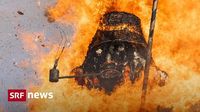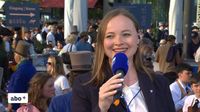The annual Sechseläuten festival in Zurich, which took place from April 25 to April 28, 2025, culminated in a spectacular display as the Böögg, a snowman effigy symbolizing winter, was burned at 6 p.m. on April 28. The event, marked by the explosion of the Böögg's head after 26 minutes and 30 seconds, drew thousands of spectators eager to witness the traditional rite that heralds the arrival of spring.
This year, the festival saw Zug serve as the guest canton for the first time in 18 years, showcasing its unique cultural identity through various festivities and exhibitions. The motto for the event was "Kirschen, Krypto und Klischees," which humorously played on stereotypes associated with the canton, such as its reputation for wealth and innovation.
As the Böögg caught fire approximately 18 minutes into the ceremony, a massive plume of smoke rose above the Sechseläutenplatz, where crowds had gathered to witness the spectacle. The Böögg, standing 3.5 meters tall and placed atop a ten-meter-high pyre, is stuffed with fireworks that create a dramatic explosion when the head finally bursts. This year’s explosion was met with cheers from the crowd, who eagerly awaited the outcome, as local lore suggests that the quicker the head explodes, the better the summer will be.
Despite the excitement, concerns were raised about the treatment of animals involved in the festivities. Animal rights advocates expressed their discontent, stating, "We had some angry reactions beforehand," highlighting the need for greater sensitivity towards the use of animals in such public events.
The Sechseläuten festival has deep historical roots, originally celebrated as a signal for the extension of working hours in spring. The tradition dates back to the 16th century, when the ringing of the bells at St. Peter's Church marked the end of winter and the beginning of longer days. Today, it is a vibrant celebration featuring a parade of guilds, with approximately 3,500 participants, over 350 riders, and numerous music corps.
This year, the festival featured two main parades: the Kinderumzug on Sunday, which welcomed between 2,000 and 3,000 children dressed in traditional costumes, and the Zug der Zünfte on Monday afternoon. The latter saw members of Zurich's 26 guilds, dressed in historical attire, parade through the city, culminating in the Böögg's burning.
Among the notable attendees were four members of the Swiss Federal Council: Martin Pfister, Ignazio Cassis, Guy Parmelin, and Albert Rösti. Pfister, representing Zug, remarked on the significance of the event, recalling his childhood anticipation of the Böögg's explosion. He noted, “I waited eagerly for the explosion of the Böögg as a child,” reflecting the festival's personal and communal connections.
The festivities also included a live broadcast and coverage by local media, with reporters stationed throughout the event to capture the atmosphere and engage with participants. Notably, there was no public viewing area on the Münsterhof this year, as previous arrangements had resulted in overcrowding.
As the Böögg was finally set ablaze, the air was filled with anticipation. The explosion, although slightly delayed, brought jubilation among the crowd. Many took to social media to express their excitement, while others speculated about the implications of the Böögg's burning time for the upcoming summer. Historically, the Böögg's predictions have been mixed, with some years correlating with hotter summers and others not.
In the aftermath of the event, cleanup crews were dispatched to the Sechseläutenplatz to restore the area, which had been littered with remnants from the celebrations, including horse manure and discarded cups. The traditional Volksbräteln, a communal grilling event, began as the fire from the Böögg's pyre waned, with attendees gathering to cook sausages and enjoy the festive atmosphere.
Despite some criticisms regarding animal welfare and the sustainability of traditions, the Sechseläuten remains a cherished event in Zurich's cultural calendar. It serves as a reminder of the city's rich history and its ability to bring together people from diverse backgrounds in celebration.
As the sun set on this year’s festivities, Zurich's residents and visitors alike were left with memories of a vibrant celebration, eagerly awaiting what the summer might bring, guided by the Böögg's ambiguous predictions.



